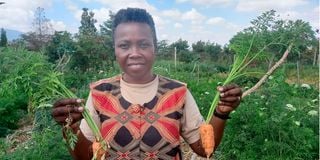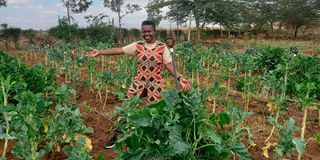Premium
Why farmer took the agroecology route

Sylvia Kuria at her farm in Lare. She is a successful agroecology farmer.
What you need to know:
- Sylvia Kuria employs several strategies to get the best and most yields, including companion planting.
- She encourages organic farmers to form networks to enable them sell their produce effortlessly.
The bumpy ride off the Maai Mahiu-Naivasha highway to Lare village is a test of nerves, as trucks loaded with quarry materials approach from the opposite direction.
Then there are sounds of machines crushing rocks and dust filling the air.
Tucked between quarries is a 10-acre agroecology farm. Near the farm’s main gate are naturally grown sukuma wiki, spinach and other greens as overhead sprinklers work tirelessly at a distance.
Employees go about their chores with clockwise precision, ensuring everything – including a chaff cutter – is in motion.
Bulls in one of the sheds cannot keep calm as they wait to be fed. A worker is nearby preparing the feed.
Sylvia Kuria is taking journalists around her farm. She talks to her workers, making enquiries and directing operations while taking notes.
“I have made it a habit to take annotations whenever I am doing rounds on the farm,” she says and recalls how the venture started about 15 years ago.
“I did not even know the word agroecology when I began farming,” she admits.
“I later realised it was not just a matter of putting chemicals in the soil. There were other practices to be incorporated, including crop rotation, water harvesting, agroforestry and even creating a micro climate.”
Ms Kuria was introduced to agroecology six years ago. The farming method aims at increasing harvests, while reducing damage to the environment.
She acquired driplines and sprinklers, wholeheartedly taking up the capital-intensive venture.

Sylvia Kuria at her farm in Lare. She is a successful agroecology farmer.
“We now make good use of solar energy. Unfortunately, many farmers do not have access to money to facilitate automation,” Ms Kuria says.
She employs several strategies to get the best and most yields, including companion planting.
“We plant crops that help repel each other’s pests. Onions and carrots, for instance, work well as companions. Leek onions and cabbage too. Leek repels a very destructive pest called diamondback moth,” she says.
Ms Kuria also vouches for crop rotation, showing an area near the farm where she planted tomatoes that attracted spider mites.
“Crop rotation helped destroy the mites. We also make pesticides. The most common is a concoction made from ash. We mix the ash with Tithonia diversifolia, which is grown as a companion plant,” she says.
The other commonly used natural extract for fighting pests is neem oil (mwarubaini).
“The most important thing is to work on the soil and enable it to produce healthy plants. Pests need to be repelled naturally.”
Marketing her produce was difficult at first but Ms Kuria solved that by opening a shop.
“We do the selling of our organic produce. We have also contracted small-scale farmers to supply us their produce. The market has stabilised,” she says.
Ms Kuria encourages organic farmers to have linkages and form networks as that will enable them sell their vegetables, legumes, nuts, oil crops, grains or fruits effortlessly.
She, however, urges the government to come up with laws on agroecology, and calls for banning “highly hazardous pesticides”.
“When distributing synthetic fertiliser, farmers need to be given organic inputs too. We need a policy on waste management,” she says.
She hails Biovision Africa Trust (BvAT) for working with smallholder farmers to increase yields and improve human, animal, plant and environment health through relevant and effective information based on research and proven practices.





